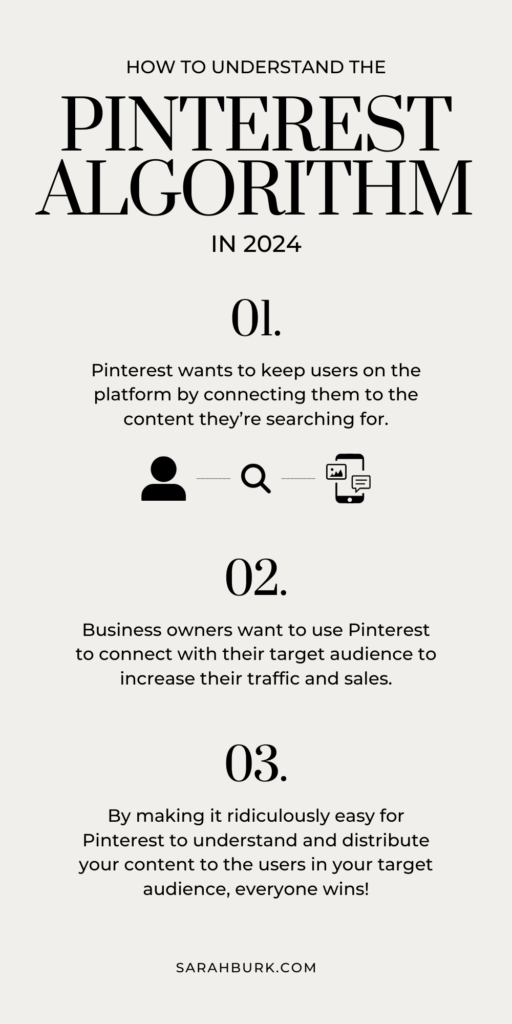It’s not a secret that the Pinterest algorithm has been through it in the past few years. The Pinterest algorithm in 2025 looks a lot different than the Pinterest algorithm in 2016!
Even though a lot of Pinterest marketers and bloggers will complain about the “new Pinterest” and that it’s much harder to see success, trust me when I say the new Pinterest algorithm is actually better for you and your business. You just have to understand it to leverage it properly!
What is the Pinterest algorithm?
The first thing you need to know about the Pinterest algorithm is that it isn’t out to get you. It doesn’t even really care about you at all. (This is a good thing, I promise.)
The truth about the Pinterest algorithm, or any social media platform’s algorithm, is that its end goal is to make Pinterest more money. When you peel back all the fluff, layers, and marketing, Instagram, TikTok, Pinterest, YouTube, you name it… are corporations. They want to make more money.
The way these platforms make money is through advertising. And in order to charge more for those ad placements, platforms want to have higher user engagement and retention. So what does that mean for the Pinterest algorithm?
Pinterest’s goal is to keep users on the platform. The more users stay on the Pinterest app, the more ads they see, which in turn increases Pinterest’s revenue and user engagement metrics.
The best way to keep users on Pinterest is to make them happy by connecting the users with the content they’re searching for or that Pinterest thinks they want to see.
So… how does the Pinterest algorithm work to make that happen? The Pinterest algorithm uses a combination of user activity and keyword-based content categorization to distribute content. Here’s a look at some of those ranking factors in more detail:
How the Pinterest algorithm actually works in 2025
How Pinterest Distributes Content to Users
From a Pinterest user perspective, what you see depends on a few different factors:
- What you search for
- What you interact with
- Who you follow
What You Search For:
If you search for something on Pinterest, the Pinterest algorithm is going to take the search term you used as the primary “filter” for the content they show you. The Pinterest robots are going to sort through all the content on the site for pins that match the search terms you entered.
But what turns up in one person’s “home decor” search results might be very different than what turns up in someone else’s. That’s because Pinterest uses your past searches and engagement with pins to tailor the search results to your unique user behavior and interests.
What You Engage With:
You might have noticed this so-called “Pinterest Effect” before if you’ve ever spent time on Pinterest for a particular project or reason. You save one pin about kitchens with brick flooring and then all of a sudden the next time you open the app your feed is flooded with brick floors.
That’s because by saving that one pin, you’ve told Pinterest that you’re interested in that particular content, even if you never typed it into the search bar. The Pinterest algorithm is trying to anticipate your desires and serve up visually similar content on a virtual silver platter.
If you’re familiar with the TikTok for you page, it’s the same function. The more you engage with content of a particular type, the more you’ll see it. Remember, the algorithm is just trying to keep users happy.
Who You Follow:
Honestly, I hesitate to even add who you follow to the list of what influences the Pinterest algorithm because it is such a minuscule part of the overall equation. However, the Pinterest accounts you follow do slightly impact the content you see on Pinterest.
Do Followers Really Matter on Pinterest?
The impact of who you follow on Pinterest is one of the biggest changes to the Pinterest algorithm. If you’ve been a Pinterest user for a while, you might remember that there was a “Following” feed available for you to browse on Pinterest. This feed would contain only content from the Pinterest accounts you followed, which meant you had a higher likelihood of seeing more content from those accounts.
Now, there is no “Following” feed on Pinterest. You just have one home feed, the contents of which are determined by the other two factors we just discussed: what you search for and what you engage with. That being said, if you follow a Pinterest account, you are slightly more likely to see their content if you search for or engage with similar pins.
What I mean is that if you search for chocolate chip cookie recipes, you’re not going to see a blog post from your brand designer pop up in the results just because you follow her. But if you searched for branding inspiration, your search results might lean a little more towards her content than if you didn’t follow her.
How to Hack the Pinterest Algorithm in 2025
Now that we know the factors that influence what a Pinterest user sees, let’s talk about how to get the Pinterest algorithm to show users your content. Because as a business owner, your purpose in using Pinterest is to get your content in front of your target audience so they can click on your website, join your email list, and eventually buy from you.
The easiest way to understand how your content gets distributed by the Pinterest algorithm is if we take a look at what happens after publishing a pin.
First, Pinterest crawls your pin for relevant data, including but not limited to:
- Pin title + description
- Text on the pin graphic
- Visual similarities between the graphic and other pins of similar topics
- The board title and description you’re pinning to
- The other pins in that board
- Your link’s meta description
- If that link has been pinned before
Using that data, Pinterest assigns your pins different “interests” and indexes it into the platform.
When a user searches for something on Pinterest, the Pinterest algorithm returns content based on the given search term and the user’s past engagement activity.
If your content matches what the user is searching for, your content will be part of those search results, meaning you’ve reached a new potential client and the algorithm has successfully done its job!
So if you’re wondering how to hack the Pinterest algorithm in 2025, I have to be honest — you can’t. The developers behind Pinterest are really freakin’ smart, and there’s not a lot you can do to “trick” an algorithm into giving you explosive success.
The best way to use the algorithm to your benefit isn’t by hacking it or working around it. Instead, work with the Pinterest algorithm so you can both achieve your goals.
The Key to the Pinterest Algorithm in 2025
Remember, Pinterest’s goal is to keep users on the platform by connecting them with the content they’re searching for. You can make the Pinterest algorithm happy by making it ridiculously easy for Pinterest to understand and show your content to users within your target audience. It’s a win-win-win situation!
The primary way to do this is by using Pinterest SEO.
Pinterest SEO is the process of optimizing your content to make it discoverable by search engines (in this case, Pinterest), which is done by using relevant keywords (the words and phrases your audience is searching on the platform).
As a business marketing on Pinterest, the main thing you need to know about how the Pinterest algorithm works is keywords.
Not to be cliche, but keywords are, in fact, key.
Which prompts another question — what about hashtags? You can get the full breakdown about hashtags on Pinterest in 2025 here, but short answer: you don’t need to worry about them.
If you’re ready to learn more about Pinterest SEO, including how to find your Pinterest keywords and where to use them, these blogs might be of interest to ya:
How to Do Pinterest Keyword Research
Where to Use Your Pinterest Keywords

Although this image was created in 2024, the information is still accurate for 2025!
Knowing how Pinterest works is just the beginning…
Success on Pinterest can be pretty easy when you know how the Pinterest algorithm works.
What’s harder is growing in the right way to reach the right audience that’s going to join your list, buy your products, and inquire about your services. Algorithm hacks can’t solve that particular problem, especially if you don’t know why they work.
And if you don’t know why the hacks work, you’re always going to be searching for the next one.
What if you didn’t have to rely on hacks and instead knew how to create captivating content that made both the Pinterest algorithm and your audience happy?
When you truly understand your audience and the platform you’re marketing on, you can create content consistently, confident that it’ll work to bring in leads and sales for months, no matter what new trends and changes to the Pinterest algorithm go down.
The bad news is that I can’t figure those specifics out for you. But the good news is I can guide you through the whole process! Take a peek inside my signature Pinterest content strategy process and learn exactly how to create a sustainable and successful content strategy for your Pinterest marketing in this 90-minute training!
